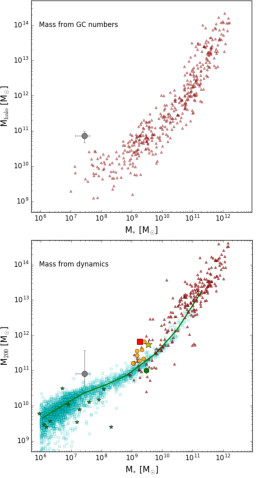A series of recent deep-imaging surveys has revealed dozens of lurking ultra-diffuse galaxies (UDGs) in nearby galaxy clusters. A new study provides key information to help us understand the origins of these faint giants.
What are UDGs?
There are three main possibilities for how UDGs — galaxies with the sizes of giants, but luminosities no brighter than those of dwarfs — formed:
- They are “tidal dwarfs”, created in galactic collisions when streams of matter were pulled away from the parent galaxies and halos to form dwarfs.
- They are descended from “normal” galaxies and were then altered by tidal interactions with the galaxy cluster.
- They are ancient remnant systems — large galaxies whose gas was swept away, putting an early halt to star formation. The gas removal did not, however, affect their large dark matter halos, which permitted them to survive in the cluster environment.
The key to differentiating between these options is to obtain mass measurements for the UDGs — how large are their dark matter halos? In a recent study led by Michael Beasley (Institute of Astrophysics of the Canary Islands, University of La Laguna), a team of astronomers has determined a clever approach for measuring these galaxies’ masses: examine their globular clusters.
Masses from Globular Clusters

VCC 1287’s mass measurements put it outside of the usual halo-mass vs. stellar-mass relationships for nearby galaxies: it has a significantly higher halo mass than is normal, given its stellar mass. [Adapted from Beasley et al. 2016]
The two masses they found are in good agreement with each other; both are around 80 billion solar masses. This is an unprecedented factor of 3,000 larger than the stellar mass for the galaxy (obtained from the galaxy’s luminosity) — which means that VCC 1287 has an unusually large dark matter halo given its stellar population.
Clues to Origins
This result makes it unlikely that VCC 1287 is a tidal-dwarf system, since these usually have dark-matter fractions of less than 10%. The authors also don’t believe it is a tidally stripped system, since no obvious tidal features were revealed in their imaging. Instead, they think the most probable scenario is that VCC 1287 is a massive dwarf galaxy that had its star formation quenched by gas starvation as it fell into the Virgo cluster long ago.
To learn whether VCC 1287 is typical of UDGs, the authors encourage finding additional UDG masses using the same techniques outlined in this study. Additional observations of the globular-cluster populations for UDGs will significantly help understand these unusual galaxies.
Citation
Michael A. Beasley et al 2016 ApJ 819 L20. doi:10.3847/2041-8205/819/2/L20


1 Comment
Pingback: ultra diffuse galaxies: tidally stretched dwarfs